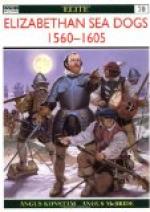Priority, publicity, and romantic wealth all favored Columbus and the south then as the memory of them does to-day. The four hundredth anniversary of his discovery of an island in the Bahamas excited the interest of the whole world and was celebrated with great enthusiasm in the United States. The four hundredth anniversary of the Cabots’ discovery of North America excited no interest at all outside of Bristol and Cape Breton and a few learned societies. Even contemporary Spain did more for the Cabots than that. The Spanish ambassador in London carefully collected every scrap of information and sent it home to his king, who turned it over as material for Juan de la Cosa’s famous map, the first dated map of America known. This map, made in 1500 on a bullock’s hide, still occupies a place of honor in the Naval Museum at Madrid; and there it stands as a contemporary geographic record to show that St. George’s Cross was the first flag ever raised over eastern North America, at all events north of Cape Hatteras.
The Cabots did great things though they were not great men. John, as we have seen already, sailed out of the ken of man in 1498 during his second voyage. Sly Sebastian lived on and almost saw Elizabeth ascend the throne in 1558. He had made many voyages and served many masters in the meantime. In 1512 he entered the service of King Ferdinand of Spain as a ‘Captain of the Sea’ with a handsome salary attached. Six years later the Emperor Charles V made him ’Chief Pilot and Examiner of Pilots.’ Another six years and he is sitting as a nautical assessor to find out the longitude of the Moluccas in order that the Pope may know whether they fall within the Portuguese or Spanish hemisphere of exploitation. Presently he goes on a four years’ journey to South America, is hindered by a mutiny, explores the River Plate (La Plata), and returns in 1530, about the time of the voyage to Brazil of ’Master William Haukins,’ of which we shall hear later on.
In 1544 Sebastian made an excellent and celebrated map of the world which gives a wonderfully good idea of the coasts of North America from Labrador to Florida. This map, long given up for lost, and only discovered three centuries after it had been finished, is now in the National Library in Paris.[1]
[1: An excellent facsimile reproduction of it, together with a copy of the marginal text, is in the collections of the American Geographical Society of New York.]
Sebastian had passed his threescore years and ten before this famous map appeared. But he was as active as ever twelve years later again. He had left Spain for England in 1548, to the rage of Charles V, who claimed him as a deserter, which he probably was. But the English boy-king, Edward VI, gave him a pension, which was renewed by Queen Mary; and his last ten years were spent in England, where he died in the odor of sanctity as Governor of the Muscovy Company and citizen of London. Whatever his faults, he was a hearty-good-fellow with his boon companions; and the following ‘personal mention’ about his octogenarian revels at Gravesend is well worth quoting exactly as the admiring diarist wrote it down on the 27th of April, 1556, when the pinnace Serchthrift was on the point of sailing to Muscovy and the Directors were giving it a great send-off.




